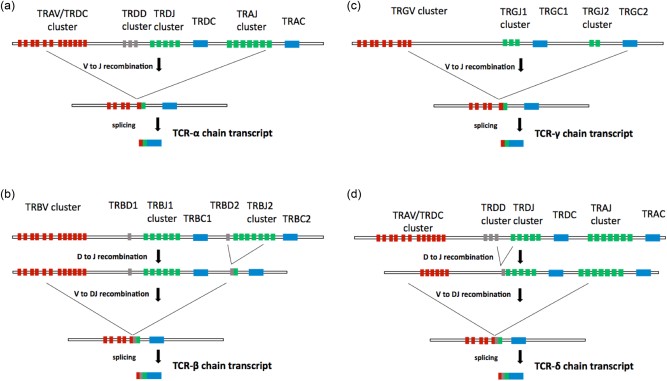Generation of αβ and γδ T cell receptors (TCRs) by V–(D)–J recombination. (a) The tra/trd locus consists of a cluster of 46 functional T cell receptor alpha variable (TRAV) segments and eight T cell receptor delta variable (TRDV) segments, followed by three segments in the T cell receptor delta diversity (TRDD) cluster and four segments in the T cell receptor delta joining (TRDJ) cluster. A total of 51 functional TRAV segments lie between the TRDC and the T cell receptor alpha chain constant region (TRAC) segments. At the tra/trd locus, V–J recombination brings together one of many TRAV segments and one of many TRAJ segments. The intervening sequences are spliced out, producing a TCR-α transcript in which V, J and C segments are directly adjacent. (b) The trb locus comprises 48 functional T cell receptor beta variable (TRBV) segments followed by two D segments, 12 functional TRBJ segments and two TRBC segments. For TCR-β chain rearrangements, V–(D)–J recombination is a two-step, ordered process. D–J recombination occurs first, juxtaposing TRBD1 to one of many TRBJ1 segments or TRBD2 to one of many TRBJ2 segments. V–DJ recombination subsequently brings the rearranged DJ join to one of many TRBV segments. The intervening sequences are then spliced out, generating a TCR-β transcript in which V, D, J and C segments are directly adjacent. (c) The trg locus is composed of six functional TRGV segments and five TRGJ segments followed by two TRGC segments. At the trg locus, V–J recombination joins one of many TRGV segments to a TRGJ segment. Similar to TCR-α chains, the intervening regions are spliced, producing a TCR-γ transcript in which V, J and C segments are directly adjacent. (d) The generation of TCR-δ chains also occurs at the tra/trd locus. The 5′ end of this locus consists of a cluster of V genes. All V genes in this cluster can recombine with TRAJ, but only a subset can recombine with TRDD. Thus, many V genes in the tra/trd locus are used exclusively for TCR-δ rearrangement in early thymic precursors, while others are used exclusively for TCR-α rearrangement in double-positive thymocytes. Some V genes can be used interchangeably. Similar to TCR-β chains, TCR-δ chains are produced by V–(D)–J recombination and splicing, producing a final transcript in which V, D, J and C segments are directly juxtaposed. Unlike the TCR-β chain, however, TCR-δ can incorporate multiple D segments.
